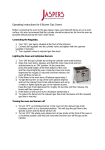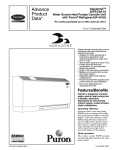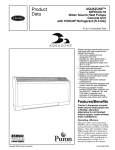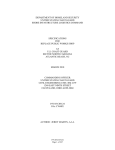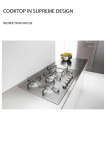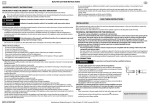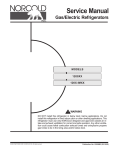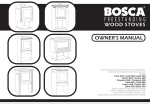Download Whirlpool Gas Range Direct Spark Ignition System
Transcript
KR-28 WHIRLPOOL GAS RANGE DIRECT SPARK IGNITION SYSTEM JOB AID Part No. 8177893 FORWARD This Job Aid, “Whirlpool Gas Range Direct Spark Ignition System,” (Part No. 8177893), provides the technician with information on the operation and service of the Direct Spark Ignition System. It is to be used as a training Job Aid and Service Manual. The Wiring Diagrams used in this Job Aid are typical and should be used for training purposes only. Always use the Wiring Diagrams supplied with the product when servicing the unit. GOALS AND OBJECTIVES The goal of this Job Aid is to provide detailed information that will enable the service technician to properly diagnose malfunctions and repair the Direct Spark Ignition System. The objectives of this Job Aid are to: • Understand and follow proper safety precautions. • Successfully troubleshoot and diagnose malfunctions. • Successfully perform necessary repairs. • Successfully return the Direct Spark Ignition System to the proper operational status. WHIRLPOOL CORPORATION assumes no responsibility for any repair made on our products by anyone other than Authorized Factory Service Technicians. Copyright 2000, Whirlpool Corporation, Benton Harbor, MI 49022 - ii - Table of Contents PAGE SECTION 1 ................................................................................................................................ 1 THEORY OF OPERATION ........................................................................................................ 1 Introduction ........................................................................................................................... 1 Gas Distribution Valve .......................................................................................................... 2 Manual Oven Shutoff Valve .............................................................................................. 3 Bake & Broil Solenoid-Activated Ports .............................................................................. 4 L.P. Gas Conversion ............................................................................................................. 5 Direct Spark Ignition Control ................................................................................................. 7 Electronic Spark Ignition ....................................................................................................... 8 Cooktop Burner Operation ................................................................................................ 8 Oven Burner Operation ..................................................................................................... 9 SECTION 2 .............................................................................................................................. 11 COMPONENT ACCESS .......................................................................................................... 11 Removing The Direct Spark Ignition Control ...................................................................... 11 Removing The Gas Distribution Valve ................................................................................ 12 SECTION 3 .............................................................................................................................. 13 COMPONENT TESTING ......................................................................................................... 13 Direct Spark Ignition Control ............................................................................................... 13 Gas Distribution Valve ........................................................................................................ 17 SECTION 4 .............................................................................................................................. 19 WIRING DIAGRAM & STRIP CIRCUITS ................................................................................. 19 Wiring Diagram ................................................................................................................... 19 Strip Circuits ....................................................................................................................... 20 SECTION 5 .............................................................................................................................. 23 TECH TIPS .............................................................................................................................. 23 Diagnostic Flow Charts ....................................................................................................... 23 - iii - IMPORTANT SAFETY INFORMATION Your safety and the safety of others is very important. Important safety messages have been provided in this Job Aid. Always read and obey all safety messages. This is the safety alert symbol. This symbol alerts you to hazards that can kill or hurt you and others. All safety messages will be preceded by the safety alert symbol and the word “WARNING.” All safety messages will identify the hazard, tell you how to reduce the chance of injury, and tell you what can happen if the instructions are not followed. GENERAL INFORMATION IMPORTANT MODEL & SERIAL NUMBER INFORMATION The Direct Spark Ignition System is used on Whirlpool gas ranges produced, beginning January 3, 2000, Serial Code RK02. The Model number of these units will be a “-5” version of the current G-line gas range. Example: SF365PEGQ5 This Direct Spark Ignition System will only be available on self-cleaning gas ranges. ELECTRICAL REQUIREMENTS The supply voltage is critical for proper operation of the Direct Spark Ignition (DSI) System. The requirements are 102 to 132 VAC with the proper polarity and ground. If the electrical supply is less than 102 VAC, sparking will not be reliable. If the system is over 132 VAC, permanent damage to the DSI can occur. Proper polarity must also be supplied. If the supply polarity is reversed, the DSI control will not be able to detect the presence of a flame. Reverse polarity will not affect the cooktop operation, but the Bake and Broil burners will fail to remain lit. A proper ground is also required. The DSI control generates a significant amount of electrical noise. This noise is minimized by clamping the noise to ground. If a proper ground is not connected, the ERC may periodically display “PF,” which means that a reset has occurred in the ERC. GAS REQUIREMENTS Gas supply pressure should be a minimum of 7˝ water column pressure for natural gas, and 11˝ water column pressure for L.P. gas. However, the gas distribution valve should maintain 4˝ water column pressure for natural gas, and 10˝ water column pressure for L.P. gas. NOTE TO TECHNICIAN: Improper polarity will cause the direct spark ignition system to malfunction. Always check for proper polarity at the wall outlet before replacing parts. - iv - SECTION 1 THEORY OF OPERATION INTRODUCTION The Direct Spark Ignition System contains a Gas Distribution Valve and a Direct Spark Ignition (DSI) Control that interfaces with the Electronic Oven Control, and spark electrodes. This provides the direct spark ignition and gas distribution for Whirlpool self-cleaning gas freestanding ranges. A proper ground and the correct polarity is necessary for the DSI control to sense the pres- ence of a flame. If the polarity is reversed, or in some cases if there is a poor ground, the control will appear to operate normally. However, after an oven burner ignites, the spark will continue to occur at the burner, and the valve will then shut off after 4 seconds. This is because the DSI control does not recognize the presence of a flame when one is present (see “Monitoring System,” on page 9). Gas Distribution Valve Direct Spark Ignition Control Ignitor & Cooktop Burner Gas Valve / Ignition Switch Broil Burner Ignitor Broil Burner Bake Burner Ignitor Gas Distribution Valve Bake Burner -1- GAS DISTRIBUTION VALVE The gas distribution valve can be converted to L.P. gas, when necessary. It regulates the distribution of gas to the cooktop and both oven burners. The gas distribution valve is non-serviceable. The gas distribution valve is made up of the following features: • Natural & L.P. gas regulator • Manual oven shutoff valve • Bake & broil solenoids • Pressure tap - To measure gas outlet pressure Pressure Tap (1/8˝ - 27 N.P.T.) L.P. Conversion Cap Gas Inlet (1/2˝ Female Threads) To Bake Burner Manual Oven Shutoff Valve Electrical Terminals To Broil Burner To Cooktop Gas Distribution Valve -2- MANUAL OVEN SHUTOFF VALVE A manual oven shutoff valve is available on the gas distribution valve to shut off the gas to the oven burners. This valve will not affect the operation of the cooktop burners. When the lever is down, the gas to the oven burners is turned off. When the lever is raised, the gas to the oven burners is turned on. Manual Valve Lever Raised (Gas On) Manual Valve Lever Down (Gas Off) -3- BAKE & BROIL SOLENOIDACTIVATED PORTS The bake and broil gas supply ports are opened and closed by electrically-operated solenoids. When voltage is received from the spark ignition control for the bake or broil function, (8-18 VDC), the solenoid for that function is activated, and the valve opens to allow gas flow to the burner. The electrical connections at the valve consist of three terminals, each one sized differently to prevent incorrect wiring (see below). The solenoids require special voltage/current (8 - 18 VDC) from the direct spark ignition control to operate properly. IMPORTANT: Do not attempt to operate the solenoids with any other voltage supply. Manual Oven Shutoff Valve Electrical Terminals: Broil = 1/8˝ wide Common = 1/4˝ wide Bake = 3/16˝ wide 216 Ω Resistance Across Each Solenoid Terminal 8 to 18 VDC NOTE: Always check both solenoids. If either solenoid is defective, neither one will operate. -4- L.P. GAS CONVERSION The range is manufactured to use natural gas. To convert the range to use L.P. gas, the following steps are performed: 1. Turn off the gas and electrical supplies to the range. 2. Remove the storage drawer from the range. 3. Locate the gas distribution valve at the rear of the range. To convert the gas distribution valve: a) Unscrew the conversion cap from the gas distribution valve. Note the difference between the L.P. and natural gas ends of the cap. L.P. Gas 4. To convert the bake burner: a) Open the oven door and remove the oven racks. b) Use a 1/2" open-end wrench and turn the orifice hood down snug onto the pin (approximately 2-1/2 turns). DO NOT OVERTIGHTEN THE ORIFICE. The burner flame cannot be properly adjusted if this conversion is not made. Pin Orifice Hood Natural Gas: Unit is manufactured for natural gas L.P. Gas: Turn down 2-1/2 turns in this direction Natural Gas b) Install the conversion cap on the gas distribution valve with the L.P. side facing up (you will see L.P. stamped inside the cap, as shown). L.P. Gas -5- 5. To convert the cooktop burners: NOTE: The L.P. orifices for the cooktop burners are supplied in the literature pack inside the oven. 6. To convert the broil burner: a) Open the oven door and remove the oven racks. b) Use a 1/2" open-end wrench and turn the orifice hood down snug onto the pin (approximately 2-1/2 turns). DO NOT OVERTIGHTEN THE ORIFICE. The burner flame cannot be properly adjusted if this conversion is not made. a) Use an 8 mm socket and carefully remove the orifice spud from each of the four burners. Broil Burner Orifice Surface Burner Orifice 8mm Socket Pin Orifice Hood Natural Gas: Unit is manufactured for natural gas b) Install the four L.P. gas orifices in the burners. L.P. Gas: Turn down 2-1/2 turns in this direction 7. -6- Reinstall the storage drawer and oven racks. DIRECT SPARK IGNITION CONTROL The Direct Spark Ignition (DSI) Control interfaces with the Electronic Oven Control for the Bake, Broil, and Self-Clean functions. The DSI also interfaces with the four cooktop burner ignition switches, to provide ignition for the cooktop. J1 DIRECT SPARK IGNITION CONTROL 10 9 7 6 The DSI control uses a self-diagnostic test to verify that the oven ignition system is working properly. It will also continually monitor the flame presence within the oven. The DSI control operates on 102 to 132 VAC. All input and output testing is performed at the J1 connector (see below). 4 3 2 1 10-PIN CONNECTOR TOP BURNERS GND BAKE BROIL J1 Bake Valve Output Valve Common Broil Valve Output Neutral 1 Bake Input Broil Input 6 7 Top Burner Input L1 9 10 DIRECT SPARK IGNITION ELECTRONIC CONTROL 2 3 4 T4 J7 Right Front Spark Output J8 J5 Left Front Spark Output Right Rear Spark Output J1 T3 J6 Left Rear Spark Output T2 J2 J4 Chassis Ground T1 Bake Burner Spark Output Broil Burner Spark Output -7- J3 ELECTRONIC SPARK IGNITION COOKTOP BURNER OPERATION The top burner spark ignition system is initiated when the burner control is turned to the LITE position. 120 VAC is supplied through the ignition switch from the L1 side of the circuit to the direct spark ignition control at input J1-9 on the control. The circuit is completed through output pin J1-4 to the neutral side of the circuit. This 120 VAC is detected by the control, and generates two sparks-per-second to all of the top burners. Note that in the strip circuit below, 120 VAC is present at the control at all times through input pin J1-10, and output pin J1-4. 120 VAC is required to: a) Monitor the internal self-diagnostics of the control board. b) Monitor the flame safety circuits to both of the oven burners. NOTE: The top burners are operator-monitored, and do not require electronic monitoring. Cooktop Strip Circuit L1 BK IGNITION SWITCH N R BK W DIRECT SPARK IGNITION CONTROL J1 10 9 7 6 4 3 2 1 10-PIN CONNECTOR TOP BURNERS -8- GND OVEN BURNER OPERATION The spark ignition for the oven burners is started at the Electronic Oven Control (ERC). As the ERC is programmed for Bake or Broil, the appropriate relay is closed on the ERC. 120 VAC is provided from L1, through the ERC relay(s) to the direct spark ignition control at input pin J1-6 (Bake), or J1-7 (Broil), to the neutral side of the circuit, through output pin J1-4. This 120 VAC is used to generate two sparksper-second to both oven burners. The 120 volts AC is also stepped-down to between 8 and 18 VDC through pins J1-1 and J1-2 (Bake), and pins J1-3 and J1-2 (Broil). This DC voltage opens the gas distribution valve, and provides gas to the appropriate oven burner. OVEN CONTROL (ERC) L1 BK N BROIL RELAY P2-1 BAKE VALVE V P1-4 OVEN TEMP SENSOR P1-5 V P2-4 BAKE RELAY R R OR W BK J1 10 9 7 6 4 3 2 1 10-PIN CONNECTOR DIRECT SPARK IGNITION CONTROL GND BAKE BROIL Bake Operation BROIL VALVE L1 N OVEN CONTROL (ERC) BK P2-1 V BROIL RELAY P2-2 BU BU OR P1-4 J1 10 9 OVEN TEMP SENSOR W 7 6 4 3 2 1 10-PIN CONNECTOR V P1-5 BAKE RELAY DIRECT SPARK IGNITION CONTROL GND BAKE BROIL BK Broil Operation Monitoring System When power is applied to the range, a safety delay of 40 seconds takes place before the direct spark ignition control becomes operational. The 40 second delay allows any unused gas inside the oven cavity to dissipate before a spark is activated. When the Bake or Broil operation is activated, the direct spark ignition control initiates an “internal self-test” and “flame safety check.” The flame safety check takes place anytime there is a flame present at either oven burner. The self-test checks both solenoids on the gas distribution valve to verify that they are properly connected. If they are not, the control will turn the oven off, or lock it out. If the test is successful, the control will then open the appropriate valve, and initiate sparking at the burner ignitor. Both the bake and broil ignitors spark simultaneously. Sparking will not occur until the gas distribution valve opens. -9- Once the gas has ignited, the “flame safety circuit” will monitor the flame at the burner to make sure it is present. If a flame is not present at the burner: a) The control will allow the ignitor to spark for 4 seconds. b) A 40 second delay to dissipate any unused gas inside the oven will occur. The ignition attempt will occur three times. If the burner does not ignite after the three attempts, the system will “lockout” (see the Timing Chart below). Lockout The control will perform an oven system lockout if: a) Any of the self-test checks fail. b) The oven fails to ignite after three ignition attempts. Time (sec) 0 0.5 1.0 c) A flame is present within the oven for more than 10 seconds after the gas valve is off. d) The flame is unexpectedly lost for any reason after being established. NOTE: If this occurs, a lockout condition will occur after 30 seconds with no attempt to reignite. During the lockout, the gas distribution valve and ignition are turned off. All lockouts can be reset by pressing the OFF/Cancel keypad on the Electronic Oven Control. NOTE: There will be no indication on the electronic oven control display showing a lockout condition. Note To Technician: The cooktop spark operates normally even when the oven is in the “lockout” mode. If the oven does not appear to work at all, verify the operation of the cooktop spark. If the cooktop spark is working correctly, the DSI control is most likely okay, and the problem is somewhere else in the range. 1.5 2.0 2.5 3.0 3.5 3.0 3.5 Valve open Charge Cap Spark Flame Sense Timing Chart (Oven Burners) Timing Sequence = 4 Seconds 3 Attempts Before Lockout Time (sec) Top Spark 0 0.5 1.0 1.5 2.0 2.5 Valve Open Timing Chart (Cooktop Burners) - 10 - SECTION 2 COMPONENT ACCESS This section instructs you on how to service the direct spark ignition system components inside the Gas Range. REMOVING THE DIRECT SPARK IGNITION CONTROL WARNING 4. Disconnect the wire connectors from the direct spark ignition control. 5. 6. Remove the mounting screws. Slide the two top pins out of the bracket slots and remove the control from the bracket. ELECTRICAL SHOCK HAZARD Disconnect power before servicing the range. Replace all panels before operating range. Failure to do so can result in death or electrical shock. FIRE HAZARD Shut off gas supply line valve before servicing the range. Check all gas line connections and replace all panels before operating the range. Failure to do so could result in explosion, fire, or other injury. CAUTION: When you work on the gas range, be careful when handling the sheet metal parts. Sharp edges may be present, and you can cut yourself if you are not careful. 1. 2. 3. Turn off the gas to the range and disconnect the power cord from the wall outlet. Pull the range away from the wall so you can access the back of the unit. Remove the top rear cover (4 screws). Screw (1 of 4) Top Rear Cover - 11 - Board Pin In Slot REMOVING THE GAS DISTRIBUTION VALVE 3. WARNING ELECTRICAL SHOCK HAZARD 4. Disconnect power before servicing the range. Replace all panels before operating range. Failure to do so can result in death or electrical shock. Remove the gas outlet lines from the gas distribution valve with a 9/16˝ open-end wrench. Remove the four mounting screws from the gas distribution valve. Gas Outlet Screws FIRE HAZARD Shut off gas supply line valve before servicing the range. Check all gas line connections and replace all panels before operating the range. Failure to do so could result in explosion, fire, or other injury. Gas Distribution Valve CAUTION: When you work on the gas range, be careful when handling the sheet metal parts. Sharp edges may be present, and you can cut yourself if you are not careful. 1. 2. Gas Outlet Screws 5. Lower the gas distribution valve so that it is free of the bake burner, and lay it down, as shown below. 6. Remove the electrical connections. NOTE: The terminals are different sizes to prevent miswiring (see page 4). Turn off the gas to the range and disconnect the power cord from the wall outlet. Pull the range away from the wall so you can access the back of the unit. Gas Distribution Valve (Back of Range) - 12 - SECTION 3 COMPONENT TESTING DIRECT SPARK IGNITION CONTROL 3. WARNING Electrical Shock Hazard Voltage is present during these tests. TEST PROCEDURE Voltage Tests If the top burners spark, proceed to step 4. Touch the test leads to the J1 connector at terminals 4 (white) and 10 (black). The AC voltmeter should indicate 120 VAC. If not, check for the proper voltage at the power supply outlet, and check the main wiring harness. 10 (black) 4 (white) Bake Function 1. Set the voltmeter to read 120 VAC. 2. Program the range for the Bake operation. J1 Connector J1 Connector 4. Touch the test leads to the J1 connector at terminals 4 (white) and 6 (red/white). The AC voltmeter should indicate 120 VAC. If not, check the electronic oven control for proper operation. 4 (white) 6 (red/white) J1 Connector Bake Strip Circuit OVEN CONTROL (ERC) L1 BK P2-1 V OVEN TEMP SENSOR V N BROIL RELAY BAKE VALVE P1-4 P1-5 BAKE RELAY P2-4 R R OR W BK J1 10 9 7 6 4 3 2 1 10-PIN CONNECTOR GND BAKE BROIL DIRECT SPARK IGNITION CONTROL - 13 - 5. 6. Set the voltmeter to read between 8 and 18 volts DC. Touch the test leads to the J1 connector at terminals 1 (red) and 2 (orange). The DC voltmeter should indicate between 8 and 18 volts DC*. If not, replace the DSI control. 1 (red) Broil Function 1. Set the voltmeter to read 120 VAC. 2. Program the range for the Broil operation. J1 Connector 2 (orange) J1 Connector 3. * When power is applied to the range, a safety delay of 40 seconds takes place before the direct spark ignition control becomes operational. The operation will last for a period of 4 seconds, and the direct spark ignition will again turn off (see the “Timing Chart” for the oven burners on page 10). If the top burners spark, proceed to step 4. Touch the test leads to the J1 connector at terminals 4 (white) and 10 (black). The AC voltmeter should indicate 120 VAC. If not, check for the proper voltage at the power supply outlet, and check the main wiring harness. 4 (white) J1 Connector - 14 - 10 (black) 4. 6. Touch the test leads to the J1 connector at terminals 4 (white) and 7 (blue/white). The AC voltmeter should indicate 120 VAC. If not, check the electronic oven control for proper operation. 4 (white) Touch the test leads to the J1 connector at terminals 2 (orange) and 3 (blue). The DC voltmeter should indicate between 8 and 18 volts DC*. If not, replace the DSI control. 2 (orange) 3 (blue) 7 (blue/white) J1 Connector 5. J1 Connector * Set the voltmeter to read between 8 and 18 volts DC. When power is applied to the range, a safety delay of 40 seconds takes place before the direct spark ignition control becomes operational. The operation will last for a period of 4 seconds, and the direct spark ignition will again turn off (see the “Timing Chart” for the oven burners on page 10). Broil Strip Circuit BROIL VALVE L1 N OVEN CONTROL (ERC) BK P2-1 V BROIL RELAY P2-2 BU BU OR P1-4 J1 10 9 OVEN TEMP SENSOR 7 6 4 3 2 1 10-PIN CONNECTOR V P1-5 BAKE RELAY DIRECT SPARK GND BAKE BROIL IGNITION CONTROL BK - 15 - W 3. Cooktop Function 1. Set the voltmeter to read 120 VAC. J1 Connector Touch the test leads to the J1 connector at terminals 4 (white) and 10 (black). The AC voltmeter should indicate 120 VAC. If not, check for the proper voltage at the power supply outlet, and check the main wiring harness. 10 (black) 4 (white) J1 Connector 2. Turn one of the cooktop burner valves to the LITE position. 4. Touch the test leads to the J1 connector at terminals 4 (white) and 9 (red). The AC voltmeter should indicate 120 VAC. If not, check the ignition switch and the main wiring harness. 9 (red) 4 (white) J1 Connector Cooktop Strip Circuit L1 BK IGNITION SWITCH N R BK W DIRECT SPARK J1 10 9 IGNITION CONTROL 7 6 4 3 2 1 10-PIN CONNECTOR TOP BURNERS - 16 - GND GAS DISTRIBUTION VALVE TEST PROCEDURE Solenoid Resistance Tests 1. 2. 3. 4. Disconnect power from the range. Set the ohmmeter to the R x 100 scale. Touch the ohmmeter terminals to terminals 1 and 2 (Broil). The ohmmeter should read 216 Ω ±30. Touch the ohmmeter terminals to terminals 3 and 2 (Bake). The ohmmeter should read 216 Ω ±30. NOTE: Always check both solenoids. If one of the solenoids is defective, neither one will operate. 1 2 3 - 17 - — NOTES — - 18 - SECTION 4 WIRING DIAGRAM & STRIP CIRCUITS WIRING DIAGRAM N L1 OVEN LT. W DOOR LATCH SW. (IF EQUIPPED) ROCKER SW. (IF EQUIPPED) W W W OVEN CONTROL BK BK W BK W P6-3 P6-1 P1-2 Y P1-3 TRANSFORMER V DOOR LIGHT SW. Y GY GY P1-1 P1-4 N/O BU LATCH DRIVE OVEN TEMP SENSOR GND N/C P6-4 BR P1-5 V MOT DOOR LATCH SWITCH W LATCH RELAY 1080 W @ 72˚F P2-2 BK BU OR BU BROIL VALVE P2-1 BROIL RELAY BAKE RELAY P2-4 R R OR BAKE VALVE BK SURFACE BURNER IGNITION SWITCHES BK R J1 DIRECT SPARK IGNITION CONTROL 10 9 7 6 4 3 2 1 10-PIN CONNECTOR SEALED BURNER UNITS EQUIPPED WITH 4 IGNITORS, OPEN BURNER UNITS WITH 2 IGNITORS TOP BURNERS NOTE: Drawing shows door latch switch in the Cook position with oven door open, oven Off, and light On. GND BAKE BROIL PART NO. 8273173 - 19 - STRIP CIRCUITS BAKE OVEN CONTROL (ERC) L1 BK N BROIL RELAY P2-1 BAKE VALVE V P1-4 OVEN TEMP SENSOR P1-5 V P2-4 BAKE RELAY R R OR W BK J1 10 9 7 6 4 3 2 1 10-PIN CONNECTOR GND BAKE BROIL DIRECT SPARK IGNITION CONTROL BROIL BROIL VALVE L1 N OVEN CONTROL (ERC) BK P2-1 V BROIL RELAY P2-2 BU BU OR W P1-4 J1 10 9 OVEN TEMP SENSOR 7 6 4 3 2 1 10-PIN CONNECTOR P1-5 BAKE RELAY V DIRECT SPARK GND BAKE BROIL IGNITION CONTROL BK COOKTOP L1 BK IGNITION SWITCH N R BK W DIRECT SPARK J1 10 9 IGNITION CONTROL 7 6 4 3 2 1 10-PIN CONNECTOR TOP BURNERS - 20 - GND CLEAN L1 N W OVEN CONTROL P6-3 P6-1 TRANSFORMER V P1-2 DOOR SWITCH Y GY P1-3 P1-1 P1-4 Y GY N/O BU DOOR LATCH SW LATCH DRIVE P1-5 OVEN V TEMP SENSOR LATCH RELAY 1080 W @ 72˚F BK P6-4 BR MOT W BROIL VALVE P2-2 OR BU BU P2-1 BAKE VALVE BROIL RELAY BAKE RELAY P2-4 R R J1- 10 9 7 6 4 3 2 1 10-PIN CONNECTOR DIRECT SPARK GND BAKE BROIL IGNITION CONTROL - 21 - OR — NOTES — - 22 - SECTION 5 TECH TIPS DIAGNOSTIC FLOW CHARTS COOKTOP Start NOTE: The range must be plugged in for at least 40 seconds before this test can begin. Does cooktop spark properly? yes Done no Check the high voltage igniter wires for continuity and proper connections from DSI control to igniters. Make sure the burner caps are the correct size and are properly oriented. Also, if the supply voltage is less than 102 VAC, the spark might not occur. Diagnose the main wiring harness. 120 VAC should always be present at this point. no Is 120 VAC present from J1-4 to J1-10? yes Diagnose the cooktop wiring harness. Check the cooktop switches for the proper function. no With the cooktop knob in LITE, is 120 VAC present from J1-4 to J1-9? yes Replace the DSI control. - 23 - BAKE Done Check the polarity of the supply voltage. Even if no ground is connected, the DSI control will not be able to sense the presence of a flame at the igniter if the polarity is reversed. yes no Does the Bake cycle function properly? Replace the gas distribution valve. Does the spark continue after a flame is present? no Check the igniter for continuity. If not okay, replace the igniter. If the supply polarity is correct, check the Bake ignition wire for a loose connection. If okay, replace the DSI control. Does the Bake burner establish a flame and then turn off? yes no yes Diagnose the main wiring harness and/or the electronic oven control (ERC). no Is 120 VAC present from J1-4 to J1-6? yes Diagnose the ERC. The DSI control will lockout if a call for Bake & Broil exists simultaneously. yes Is 120 VAC present from J1-4 to J1-7? no Measure the resistance at the distribution valve. If different than measured at the DSI control, diagnose the wiring harness. If resistances are the same as measured at the DSI control, replace the valve. Turn the ERC off. Test the distribution valve for continuity at J1-1 and J1-2, then J1-2 and J1-3. Are both resistances 216 Ω ±30? no yes If the voltage is higher than 18 VDC, check the main wiring harness for bad connections. If okay, replace the distribution valve. Connect a DC voltmeter to J1-1 (+) and J1-2 (–). Wait 40 seconds, then start a Bake cycle. 6 seconds later, does the meter indicate 8 to 18 VDC? yes no Replace the DSI control. yes Does spark occur at the Broil igniter but not the Bake? no yes Check the igniter for cracks in the ceramics. If cracks are found, replace the igniter. Diagnose the Bake igniter wiring harness. If okay, replace the control. - 24 - Does spark occur at the igniter? yes The igniter position is out of tolerance for the proper ignition. Replace the igniter and burner. BROIL Done yes no Does the Broil cycle function properly? Replace the gas distribution valve. Does the spark continue after a flame is present? no Check the igniter for continuity. If not okay, replace the igniter. If the supply polarity is correct, check the Broil ignition wire for a loose connection. If okay, replace the DSI control. Does the Broil burner establish a flame and then turn off? yes no yes Diagnose the main wiring harness and/or the electronic oven control (ERC). Is 120 VAC present from J1-4 to J1-7? no yes Diagnose the ERC. The DSI control will lockout if a call for Bake & Broil exists simultaneously. yes Is 120 VAC present from J1-4 to J1-6? no Measure the resistance at the distribution valve. If different than measured at the DSI control, diagnose the wiring harness. If resistances are the same as measured at the DSI control, replace the valve. Turn the ERC off. Test the distribution valve for continuity at J1-1 and J1-2, then J1-2 and J1-3. Are both resistances 216 Ω ±30? no yes If the voltage is higher than 18 VDC, check the main wiring harness for bad connections. If okay, replace the distribution valve. Connect a DC voltmeter to J1-3 (+) and J1-2 (–). Wait 40 seconds, then start a Broil cycle. 6 seconds later, does the meter indicate 8 to 18 VDC? yes no Replace the DSI control. yes Does spark occur at the Bake igniter but not the Broil? no yes Check the igniter for cracks in the ceramics. If cracks are found, replace the igniter. Diagnose the Broil igniter wiring harness. If okay, replace the control. - 25 - Does spark occur at the igniter? yes The igniter position is out of tolerance for the proper ignition. Replace the igniter and burner.





























